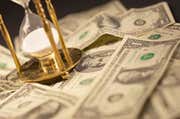“The Summary of Commentary on Current Economic Conditions by Federal Reserve District,” more commonly known as the Beige Book, is published eight times per year.
According to the Federal Reserve’s site, “Each Federal Reserve Bank gathers anecdotal information on current economic conditions in its District through reports from Bank and Branch directors and interviews with key business contacts, economists, market experts, and other sources. The Beige Book summarizes this information by District and sector. An overall summary of the twelve district reports is prepared by a designated Federal Reserve Bank on a rotating basis.”
The information collected by the banks is qualitative versus quantitative in nature. The Fed is clear that this information should be considered “anecdotal,” and not an actual statistical release. What’s interesting to investors is how the Fed interprets the anecdotal information.
The Beige Book takes an almost conversational approach. The book has 13 sections in total; 12 regional reports from each of the member Fed district banks, preceded by one national summary drawn from the individual reports that follow it. This is the first chance investors have to see how the Fed draws logical and intuitive conclusions from raw data.
The Beige Book is published eight times per year, just before each of the Federal Open Market Committee (FOMC) meetings. While it is used by committee members during the meeting itself, it does not carry more clout than other data values and indicators. There is a lot of real-time data that the Fed has at its disposal and, unfortunately, notes from the FOMC meetings themselves are currently not public information.
The Beige Book aims to give a broad overview of the economy, bringing many variables and indicators into the mix. Discussion will be about things such as labor markets, wage and price pressures, retail and ecommerce activity and manufacturing output. Investors can see comments that are forward-looking—ones that try to predict trends and anticipate changes over the next few months or quarters.
Using the Beige Book
The Beige Book in and of itself is not something that generally impacts the markets. Rather it adds color to the other periodic numbers and statistics released by the Fed and its regional banks.
The cycle of compiling data for each release of The Beige Book starts about six weeks prior to each FOMC meeting. The updates in the The Beige Book do add value as they are updates on a number of the statistical and data series that the Fed releases during the year on various aspects of the economy. Much of this data is released with a significant lag from the time that it is initially compiled.
Strengths of The Beige Book:
- Contains forward-looking comments—the Fed districts aim to draw relative conclusions in The Beige Book, not just regurgitate facts already presented
- Gives investors a "man on the street" perspective of economic health by taking first-hand accounts from business owners, economists and others.
- Interrupts bits and pieces from different reports together into one report, using qualitative measurements instead of quantitative figures.
- It's the only indicator that gives reports by geographic region, rather than just by industry group or sector.
- Most regions will report on the state of the service industries, an area not well covered in other indicator reports, although it is a large component of real gross domestic product.
Weaknesses:
- The Beige Book is primarily anecdotal reports. The survey methodology is not done in scientific fashion.
- It’s filled with measured "Fed-speak."
- Specific industry conclusions are hard to draw from the report.
- Each Fed district can use its discretion on what to include in its report; one region may discuss manufacturing activity while others don't report on the topic. There is no standard approach across the various Fed Banks.
- Private forecasts compiled by economists and analysts tend to closely match what is reported in the Beige Book, so estimates rarely change following the release.
Economic Indicators: Business Outlook Survey
-
 Investing
InvestingLeading Economic Indicators Predict Market Trends
Leading indicators help investors to predict and react to where the market is headed. -
 Investing
InvestingBook Value: How Reliable Is It For Investors?
In theory, a low P/B ratio means you have a cushion against poor performance. In practice, it is much less certain. -
 Investing
InvestingEconomic Indicators You Should Know for Investment
Economic indicators are some of the most valuable tools investors can place in their arsenals. Understand these investing tools for better market returns. -
 Financial Advisor
Financial Advisor5 Must Read Finance Books
We'll look at 5 financial books that are perennial favorites and what has made them so popular. -
 Investing
InvestingDeep Discount-To-Book Value Stocks
With the right company, buying at a discount-to-book value could prove fruitful. -
 Insights
Insights7 Misconceptions About The Federal Reserve
There are many fallacies about the Fed. The following misconceptions are among the most popular. -
 Investing
InvestingBook Value Per Share for Banks: Is It a Good Measure? (WFC, BAC)
Find out why bank stocks usually trade below book value and understand how trading activities increase banks' risk exposures and affect valuation.



